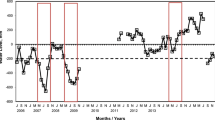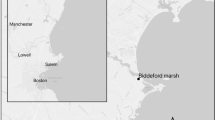Abstract
Environmental characteristics were measured and recorded in the Skagit Marsh, a brackish intertidal marsh on Puget Sound, Washington. Four transects were placed perpendicular to a known gradient of increasing salinity which began with fresh water at the bank of one of the outlets of the Skagit River and reached a surface water salinity of 22‰ at a point alongshore 5 km north of the outlet. The environmental characteristics which were measured varied along gradients (soil texture, organic carbon in fines, soil column temperature, free soil water salinity) or had a patchy distribution (soil redox potential, soil macro-organic matter). Growth and production vary across the marsh. The maximum aboveground standing crop (1,742 g m−2 dry weight) was measured at a site with 0–4‰ free soil water salinity, dominated by the sedgeCarex lyngbyei. In more saline areas (8–12‰), the bulrushScirpus americanus was dominant and standing crop values dropped to a third of the maximum. Species performance varied in a complex manner as did the environment.C. lyngbyei had diminished growth and decreased standing crop in areas where salinity was higher.S. americanus was equally productive in low elevation, high salinity sites and in high elevation, low salinity sites. An increase in shoot density for dominant species occurred in saline areas as individual shoot weights and leaf areas decreased. Because species responded differently, environmental variation was magnified in the population and community responses of the marsh vegetation.
Similar content being viewed by others
Literature Cited
Armstrong, W.. 1967. The relationship between oxidation-reduction potentials and oxygen diffusion levels in some waterlogged organic soils.Soil Sci. 18:27–33.
Burg, M. E., E. Rosenberg, andD. R. Tripp. 1976. Vegetation associations and primary productivity of the Nisqually salt marsh on southern Puget Sound, Washington, p. 104–109.In S. G. Herman and A. M. Wiedemann (eds.), Contributions to the Natural History of the Southern Puget Sound Region, Washington. Evergreen State College, Olympia.
Chapman, V. J.. 1960. Salt Marshes and Salt Deserts of the World. Interscience, New York.
Chapman, V. J.. 1976. Coastal Vegetation, 2nd Edition. Pergamon Press, Oxford.
Collias, E. E., C. A. Barnes, andJ. H. Lincoln. 1973. Skagit Bay study: Dynamical oceanography final report. University of Washington, Department of Oceanography, Seattle.
Disraeli, D. V., andR. W. Fonda. 1978. Gradient analysis of vegetation in a brackish marsh in Bellingham Bay, Washington.Can. J. Bot. 56:1308–1326.
Drinnan, W., K. J. Hall, and R. U. Kistritz. 1978. Nutrient cycling and water quality relationships in a tidal sidechannel of the lower Fraser River. West-water Research Centre, U.B.C. Technical Report, Vancouver.
Eilers, H. P.. 1975. Plants, plant communities, net production and tide levels: the ecological biogeography of the Nehalem salt marshes, Tillamook County, Oregon. Ph.D. Dissertation, Oregon State University, Corvallis, 368 p.
Ewing, K.. 1982. Plant response to environmental variation in the Skagit Marsh. Ph.D. Dissertation, University of Washington, Seattle, 203 p.
Ewing, K.. 1983. Environmental controls in Pacific Northwest intertidal marsh plant communities.Can. J. Bot. 61:1025–1039.
Ewing, K., andK. Kershaw. 1985. Vegetation of southern James Bay coastal marshes. T.A.S.O. Research Report. McMaster University, Hamilton, Ontario.
Glooschenko, W. A., andK. Clarke. 1982. The salinity cycle of a subarctic salt marsh.Nat. Can. (Rev. Ecol. Syst.) 109:483–490.
Grime, J. P.. 1979. Plant Strategies and Vegetation Processes. John Wiley and Sons, New York, 222 p.
Hoffnagle, J. R.. 1980. Estimates of vascular plant\ primary production in a west coast saltmarsh-estuary ecosystem.Northwest Sci. 54:68–79.
Jefferies, R. L., A. J. Davy, andT. Rudmik. 1977. Growth strategies of coastal halophytes, p. 243–268.In R. L. Jefferies and A. J. Davy (eds.), Ecological Processes in Coastal Environments. Blackwell Scientific Publications, Oxford.
Kershaw, K. A.. 1976. The vegetation zonation of the East Pen Island salt marshes, Hudson Bay.Can. J. Bot. 54:5–13.
Kibby, H. V., J. L. Gallagher, andW. D. Sanville. 1980. Field guide to evaluate net primary production of wetlands. Environmental Research Laboratory, Environmental Protection Agency. Corvallis, 59 p.
Kistritz, R. U.. 1978. An ecological evaluation of Fraser estuary tidal marshes: the role of detritus and the cycling of elements. Technical Report No. 15, Westwater Research Centre, Vancouver.
Kistritz, R. U., andI. Yesaki. 1979. Primary production, detritus flux, and nutrient cycling in a sedge marsh. Fraser River estuary. Technical Report No. 17, Westwater Research Centre, Vancouver.
Levings, C. D., and A. I. Moody. 1976. Studies of intertidal vascular plants, especially sedge (Carex lyngbyei) on the disrupted Squamish River delta. B.C. Fish Mar. Serv. Rept. No. 606.
Liverman, M.. 1982. Multivariate analysis of a tidal marsh ecosystem at Netarts Spit, Tillamook County, Oregon. M.S. Thesis, Oregon State University, Corvallis, 88 p.
Mason, H. L.. 1957. A Flora of Marshes of California. University of California Press, Berkeley.
Odum, E. P.. 1975. Diversity as a function of energy flow, p. 3–5.In W. H. van Dobben and R. H. Lowe-McConnel (eds.), Unifying Concepts in Ecology. Supplement. Dr. W. Junk N.V., The Hague.
Ponnamperuma, F. N.. 1972. The chemistry of submerged soils.Adv. Agron. 24:29–76.
Ranwell, D. S.. 1972. Ecology of Salt Marshes and Sand Dunes. Chapman and Hall, London.
Riley, J. L., andS. M. McKay. 1980. The vegetation and phytogeography of coastal southwestern James Bay. Life Sciences Contributions No. 124. Royal Ontario Museum. Toronto, 81 p.
Sestak, Z., J. Catsky, andP. G. Jarvis. 1971. Plant Photosynthetic Production Manual of Methods. Dr. W. Junk N.V., The Hague.
Taylor, A. H.. 1980. Plant communities and elevation in the diked portion of Joe Ney Slough: a baseline assessment of a marsh restoration project in Coos Bay, Oregon. M.S. Thesis, Oregon State University, Corvallis, 118 p.
U.S. Department of Commerce. 1980. Tide tables, west coast of North and South America. Washington, D.C.
Author information
Authors and Affiliations
Rights and permissions
About this article
Cite this article
Ewing, K. Plant growth and productivity along complex gradients in a Pacific northwest brackish intertidal marsh. Estuaries 9, 49–62 (1986). https://doi.org/10.2307/1352193
Received:
Accepted:
Issue Date:
DOI: https://doi.org/10.2307/1352193




